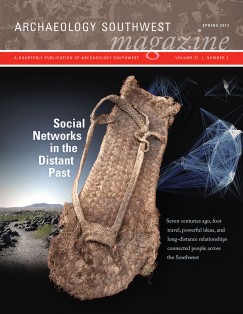- Home
- >
- Preservation Archaeology Blog
- >
- Of Ancient Networks and Bacon Numbers
 Yesterday afternoon, many of us at Archaeology Southwest gathered around the first box off the truck, grinning over the new issue of Archaeology Southwest Magazine. It’s on its way to our members’ mailboxes now (if you’re not yet a member, join now). This issue is special to me because it presents some of the most recent results from our Southwest Social Networks (SWSN) project, and because I had the pleasure of editing it.
Yesterday afternoon, many of us at Archaeology Southwest gathered around the first box off the truck, grinning over the new issue of Archaeology Southwest Magazine. It’s on its way to our members’ mailboxes now (if you’re not yet a member, join now). This issue is special to me because it presents some of the most recent results from our Southwest Social Networks (SWSN) project, and because I had the pleasure of editing it.
The SWSN project represents collaboration among a diverse group of researchers, supported by a 2008 grant from the National Science Foundation to the School of Anthropology at the University of Arizona and Archaeology Southwest. Our team, which is headed by principal investigators Barbara Mills and Jeff Clark, includes archaeologists, sociologists, geochemists, and computer scientists. We have come together to explore how tools and techniques from the interdisciplinary field known as social network analysis (SNA) might help us understand the role of regional interaction in driving some of the sweeping and important changes we see in the late precontact (A.D. 1200–1500) Southwest.
This project brought together a huge amount of data, representing the results of more than a century of formal archaeological research in the Southwest. The database that forms the basis of our analyses contains information on more than 4.3 million ceramic artifacts from more than 700 sites and more than 6,000 sourced obsidian objects from about 150 sites. These data have been added to the large settlement database known as the Coalescent Communities Database.
Briefly, SNA refers to wide variety of methods focused on formally exploring the interactions and the structure of interactions among sets of individuals, organizations, or other social groups. Most often, these networks of interaction are visualized through diagrams referred to as network graphs where individuals or groups are drawn as dots and the connections among them are drawn as lines. Networks can represent all manner of relationships such as networks of friendship, business partnerships, exchange, or co-authorship, to name just a few.
If you’ve ever played the game “Six Degrees of Kevin Bacon,” you’ve already engaged in a little SNA yourself. The premise is that Kevin Bacon may be linked to almost any other actor in the network of movie or television costars by fewer than six degrees. As you might imagine, with the rise of tools such as the IMDb, someone has actually tested this proposition. It turns out that Kevin Bacon is connected to the vast majority of working actors by an average of about 2.9 degrees. And Kevin Bacon isn’t even the most central actor in the network! As I write, that honor falls to Harvey Keitel, with an average of 2.848 degrees to other actors, followed closely by Dennis Hopper, with an average of 2.849. Bacon is actually the 370th most central actor in the network. (Google can help you determine any actor’s Bacon number, by the way. And then there are Erdös-Bacon numbers for the truly connected, but that’s another story.)

Still, even a decade ago, the concept of a “social network” would have been somewhat abstract to most people. In recent years, however, network thinking has begun to pervade our lives. This increased awareness of our social networks and their influence in our lives can likely be attributed in large part to the rise of the Internet and the popularity of platforms like Facebook and Twitter. More and more, these platforms are evolving from being simply digital places where people can connect with individuals and organizations they know or admire to platforms that are actually driving change in society. For a recent and high-profile example, consider the roles that Facebook and Twitter played in the recent Arab Spring uprisings. People used their digital networks to organize, to disseminate information, and to draw others to their cause with unprecedented speed and range.
The SWSN project shows that the importance of social networks is not merely a product of recent technological innovation. In fact, our work suggests that connections among groups of people and the structure of those connections had massive impacts on some of the most important and large-scale changes occurring in the late precontact Southwest. For example, in this issue you can read about how the arrival of migrants from the northern Southwest into the mountains and valleys of the central and southern Arizona and southwestern New Mexico dramatically altered the structure of interactions and exchange in both ceramics and obsidian at a massive scale. Further, our results suggest that network connections and the geographic scope of interactions may have influenced the longevity of sites and regions across the study area.
We also have a few cool digital features to go along with the print issue. First, if you want to use network methods and visualizations to explore your own digital networks, we have a link that will create network diagrams of your Facebook friends. Also, we’ve created a video walking through the relationship between social networks (measured through ceramics) and population through time. Finally, we’ve posted a video of an Archaeology Café presentation I gave on these topics.
